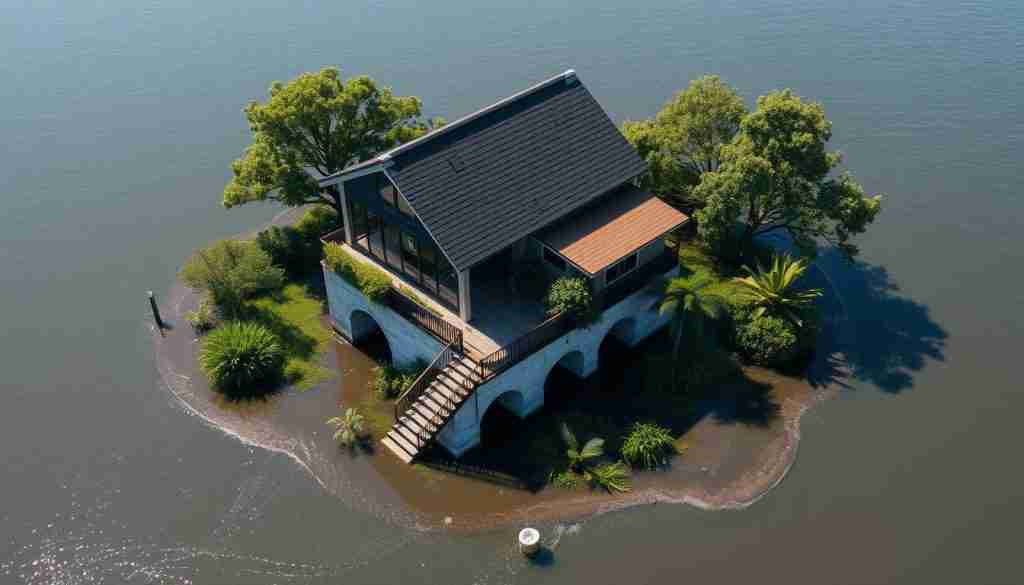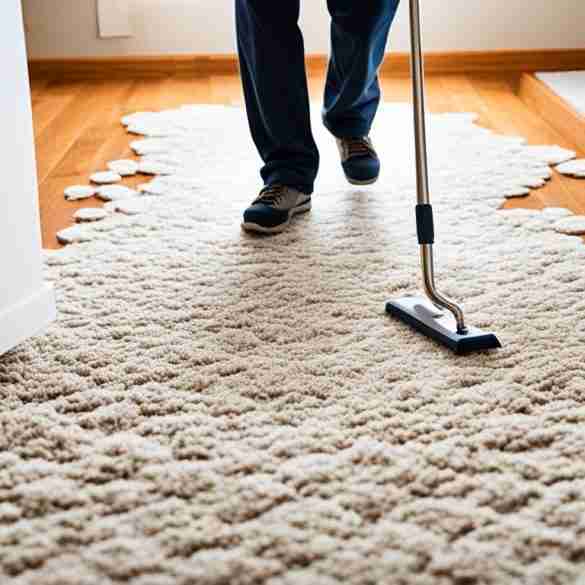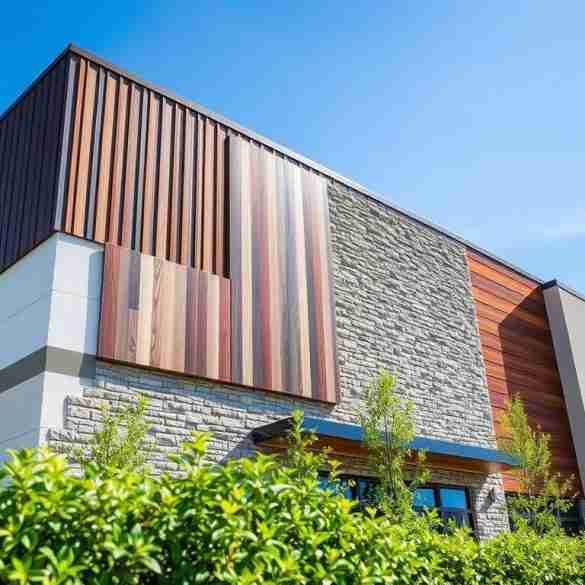In Australia, 97% of money spent after floods goes to clean-up and rebuilding. Only 3% is for making homes safer. With climate change, making homes flood-proof is more urgent than ever. Australians are looking for ways to protect their homes from floods.
This guide explores how to make homes flood-proof in Australia. We look at key ideas, strategies, and examples. You’ll learn how to make your home safe from floods.
You’ll see examples of homes that have successfully fought floods in Australia. These homes show how people can live with nature’s power. From Queensland’s stilt houses to New South Wales’ floating homes, these projects are inspiring.
Choosing flood-proof homes is important for your future. It helps your home and community stay safe. By picking flood-proof designs, you help your home last longer and make your community better for the future.
Key Takeaways
- Flood resilient design and construction can significantly reduce long-term costs for homeowners by minimizing flood damage and lowering insurance premiums.
- Key principles of flood proof house design include elevation, freeboarding, water-resistant materials, and strategic placement of flood vents and openings.
- Retrofitting existing homes with flood resilient features, such as upgraded flooring materials and flood barriers, can enhance their ability to withstand flooding events.
- Landscaping and site planning techniques, including permeable surfaces and floodplain management, play a crucial role in mitigating flood risks.
- Flood resilient building codes and regulations in Australia, along with grants and incentives, are driving the adoption of flood proof house designs across the country.
Understanding Flood Risks in Australia
As a homeowner in Australia, it’s key to know about flood risks. Learning about past floods, types of flooding, and your home’s risk helps protect your family and property.
Learning from Historical Floods
Australia has seen many devastating floods. The Brisbane floods of 1974 and 2011, and the Hunter Valley floods of 1955 are examples. These events show why flood risk management and floodplain development regulations are crucial.
Types of Flooding in Australia
Australia faces different types of flooding. The main ones are:
- Riverine flooding: caused by heavy rainfall leading to overflowing rivers and creeks
- Flash flooding: rapid flooding due to intense rainfall over a short period
- Coastal flooding: resulting from storm surges and high tides in coastal areas
- Overland flow flooding: occurs when rainfall runoff flows over land before reaching a watercourse
Knowing the types of flooding in your area is vital. Sustainable Home Magazine notes that flooding can last from a few hours to days.
Assessing Your Home’s Flood Risk
To check your home’s flood risk, look at a few things:
- Location: Is your home in known Australian flood zones?
- Elevation: How high is your home’s ground floor compared to the area?
- Proximity to water bodies: Are you near rivers, creeks, or the coast?
- Local flooding history: Has your area flooded before?
Getting a spot level for your ground floor is a good first step. It costs between $300 and $500. This info helps you choose the right flood resilience measures for your home.
| Flood Risk Scenario | Average Benefit Cost Ratio | Average Payback Period |
|---|---|---|
| High Flood Risk Areas | 1.9 to 19.6 | 1 to 12 years |
| Future Climate Change Scenarios | 1.7 to 27.3 | 1 to 14 years |
The table shows flood resilient homes are worth it. They have great benefit-cost ratios and payback periods. By investing in flood resilience, you can protect your home and save on insurance.
Benefits of Flood Resilient Home Design
Flood resilient home design is great for homeowners in Australia, especially in flood-prone areas. It helps reduce flood damage and costs. It also makes homes more adaptable to climate changes.

One big plus is lower flood damage and repair costs. Wet proofing lets water in but limits damage. Dry proofing seals the home to keep water out. This cuts down on damage and repair costs.
Reduced Flood Damage and Repair Costs
Flood resilient homes stand up to floods better. They use water-resistant materials like polished floors and sealed tiles. These materials hold little water and dry fast, making cleanup easier.
Features like elevated utilities and flood vents also help. They let water flow through without harming the home. This means less need for expensive repairs after a flood.
Lower Insurance Premiums
Insurers give discounts to homes designed to resist floods. This can lead to big savings on insurance. Sustainable Home Magazine says some homeowners save up to 50% on premiums.
These savings add up over time. They can pay for the initial cost of flood-proofing. It’s a smart move for homes in flood-risk areas.
Faster Recovery and Reoccupation
Resilient homes recover faster after floods. They suffer less damage and clean up quicker. This means you can get back to normal life sooner.
Features like elevated spaces and water-resistant materials help. They protect your belongings and make repairs easier. This lets you move back in quickly after a flood.
| Flood Resilient Design Feature | Benefit |
|---|---|
| Wet proofing | Allows water to enter the home while minimizing damage |
| Dry proofing | Seals the exterior to prevent water infiltration |
| Elevated utilities | Protects essential systems from floodwaters |
| Water-resistant materials | Absorb minimal water and dry quickly, facilitating cleanup |
| Elevated living spaces | Reduces the impact of flooding on daily life |
Choosing flood resilient design reduces stress and anxiety from floods. It means your home can handle floods better and recover faster.
Key Principles of Flood Proof House Design
When designing a flood-resilient home in Australia, there are key principles to follow. These help reduce flood damage and speed up recovery. By using these strategies, you can protect your home and family from floods.
Elevation and Freeboarding
Elevating your home above flood levels is very effective. You can use stilts or raise the foundation. Freeboarding adds extra safety. In Australia, building rules vary by state and council, so check with local authorities for elevation requirements.
Water-Resistant Materials
Using waterproof materials is crucial for a flood-resilient home. These materials should handle water well without damage. Examples include:
- Concrete and masonry blocks for foundations and walls
- Fibre-cement sheeting for exterior cladding
- Ceramic tiles or waterproof vinyl for flooring
- Marine-grade plywood for cabinetry and shelving
- Closed-cell foam insulation for walls and roof cavities
These materials help reduce flood damage and lower repair costs.
Flood Vents and Openings
Flood vents and openings let water flow through your home. This equalizes pressure and reduces damage risk. Place these openings for effective drainage and to prevent water buildup. Consider:
- Installing vents in foundation walls and garage doors
- Using open stair risers for water passage
- Incorporating weep holes in wall cavities and sub-floors
- Ensuring proper sealing around doors and windows
Controlled water flow reduces structure damage.
| Design Principle | Key Benefits |
|---|---|
| Elevation and Freeboarding | Protects home from flood waters, reduces damage |
| Water-Resistant Materials | Withstands prolonged water exposure, minimizes repairs |
| Flood Vents and Openings | Equalizes pressure, allows controlled water flow |
“The first thing to do is ask a surveyor to give you a spot level of your ground floor, which costs somewhere between $300 and $500. Once you’ve got that level, approach council about understanding whether you’re affected by overland flow, creek or riverine flooding. Knowing what types of flooding your home is vulnerable to will reveal how long it could be exposed to water during a flood and what building materials to avoid.” – Sustainable Home Magazine
By following these flood resilient architecture principles, you can build a home ready for floods in Australia. With the right planning and materials, you can lessen flood damage and speed up recovery.
Wet-Proofing vs. Dry-Proofing Strategies
In Australia, homes face flood risks. There are two main ways to protect them: wet-proofing and dry-proofing. Knowing the difference helps homeowners and builders make smart choices.
Wet-proofing is best for Brisbane homes. It means buildings can handle lots of water and still drain it out. This way, the building and its stuff stay safe.

Dry-proofing tries to keep water out by sealing buildings. But it’s not the best for Brisbane because of its floods. This method might not work well there.
More people want flood-safe homes now. This is especially true after the big flood in Brisbane in February 2022. They want their homes to be safe in future floods.
| Flood-Proofing Strategy | Description | Suitability for Brisbane |
|---|---|---|
| Wet-Proofing | Allows water to enter and drain out, minimizing damage | Recommended |
| Dry-Proofing | Prevents water from entering by sealing and reinforcing the building | Not recommended due to unique flood events |
Wet-proofing works best when you know how long and what kind of flood your home might face. For example, some floods last hours, while others can last days.
If you get water ingress in cavities or gaps between building materials, then that’s primed for mould growth and you can actually have long-term issues if you don’t let things dry out enough.
To avoid long-term moisture problems, Queensland suggests using special materials for walls. It also recommends good ventilation and moisture-resistant materials.
Understanding wet-proofing and dry-proofing helps make homes safer in Australia. Homeowners and builders can choose the best option for their property’s flood risks.
Flood Proof House Designs in Australia
Climate change is making homes in Australia more vulnerable to floods. Homeowners are looking for ways to protect their homes and families. New designs are emerging that use elevated construction, flood-resistant materials, and waterproof foundations.
Elevated Stilt Houses
Elevated stilt houses are popular in flood-prone areas. They sit on pillars, keeping the living space above flood levels. This design lets floodwater flow under the house, reducing damage and making repairs easier.
These houses often have open floor plans and high ceilings. This makes them feel spacious and well-ventilated.
Amphibious Housing
Amphibious housing is a new idea that works with water levels. It floats on a special foundation that rises and falls with the water. This design keeps the house safe during floods.
It’s anchored to the ground, so it doesn’t move around. This makes it a good choice for areas with a lot of flooding.
Floating Homes
Floating homes are built on water and can move with the water. They use waterproof materials and foundations to last long in water. While they might not work everywhere, they offer a unique lifestyle.
| Design Approach | Key Features | Suitable Locations |
|---|---|---|
| Elevated Stilt Houses | Raised living areas, open floor plans, high ceilings | Areas with occasional flooding, coastal regions |
| Amphibious Housing | Buoyant foundation, rises and falls with water levels | Regions with frequent or prolonged flooding |
| Floating Homes | Permanently situated on water, waterproof foundations | Rivers, lakes, canals, and other water bodies |
Choosing a flood-resistant home design is important. You should know your flood risk and talk to experts. These designs can help protect your home, save on repairs, and speed up recovery after a flood.
Retrofitting Existing Homes for Flood Resilience
Flood risks are growing in Australia. Retrofitting homes to be flood-resistant is key. You can protect your home and help your community by following flood-proofing guidelines and making smart upgrades.
In Queensland, $741 million was set aside to help homes adapt. This includes retrofitting, raising homes, and a buyback scheme. After the 2011 floods, Brisbane’s program made people less anxious. Taking steps to retrofit your home can make you feel safer and reduce stress from floods.
Upgrading Flooring Materials
Upgrading flooring is a big part of making your home flood-resistant. Carpets and hardwood floors can get damaged by water. They’re hard to clean and fix after a flood.
Consider using water-resistant flooring like:
- Ceramic or porcelain tiles
- Luxury vinyl plank (LVP) flooring
- Polished concrete
- Epoxy coatings
These materials resist water damage well. They’re also easy to clean and disinfect after a flood. This lets you get back into your home quickly.
Installing Flood Barriers and Shields
Installing flood barriers and shields is another good idea. They keep floodwater out of your home. You can use:
- Removable flood barriers
- Permanent flood walls
- Flood-proof doors and windows
- Sandbags and inflatable barriers (for temporary protection)
These barriers can greatly reduce floodwater getting into your home. This helps protect your home’s inside from damage.
Relocating Utilities and Electrical Systems
Floodwater can harm utilities and electrical systems. This can lead to expensive repairs and safety risks. When you retrofit, move these systems to safer places.
- Moving electrical panels, meters, and outlets above the flood level
- Installing backflow valves on sewer and septic tank lines
- Elevating HVAC systems, water heaters, and appliances
- Using waterproof wiring and connectors in flood-prone areas
By moving and protecting these systems, you can avoid big problems. This makes it easier to get back to normal after a flood.
| Retrofitting Measure | Benefits |
|---|---|
| Upgrading Flooring Materials | Water-resistant, easier to clean and restore post-flood |
| Installing Flood Barriers and Shields | Prevents floodwater infiltration, minimizes interior damage |
| Relocating Utilities and Electrical Systems | Reduces damage, ensures faster recovery, improves safety |
Retrofitting your home for flood resilience does more than protect your property. It helps your whole community. By following these guidelines and investing in flood resilience, you can keep your home safe. This reduces anxiety and helps you recover faster from floods.
Building Materials for Flood Resilient Homes
Building disaster-proof homes in flood areas needs the right materials. Waterproof and sustainable options help a home stay strong against water damage. These materials can handle water, stop mold, and help a home recover fast after a flood.
It’s important to avoid gaps in building materials. Spaces like the area between cladding and walls can trap water. This leads to mold and long-term problems if not dried out. Solid walls made of concrete, brick, or stone are best in flood areas.
For floors, choose water-resistant options like polished concrete, ceramic tiles, or vinyl. These dry quickly and are easy to clean. Carpets and wooden floors, however, can get damaged by water and should be avoided.
Use fiber cement sheeting and moisture-resistant insulation for walls. These materials can handle water and don’t support mold like traditional drywall. Also, water-resistant skirting above flood levels helps protect walls from water damage.
Too much mold can harm your health, causing allergies or poisoning by mycotoxins.
Other materials and strategies for flood resilience include:
- Flood-resistant doors and windows with sealed frames and waterproof gaskets
- Elevated electrical outlets and wiring to avoid electrical hazards during a flood
- Water-resistant cabinetry and shelving from materials like stainless steel or marine-grade plywood
- Flood vents and openings to let water flow and prevent damage
Using these waterproof materials and solutions makes homes more resilient against floods. While it costs more upfront, it saves money on repairs and insurance. It also helps homes recover faster, making it a smart choice for flood-prone areas.
Landscaping and Site Planning for Flood Mitigation
Good site planning and landscaping are key to reducing flood risks in Australia. Using sustainable building methods and following floodplain codes helps manage flood risks. This way, you can protect your property from damage.

Permeable Surfaces and Drainage
Using permeable surfaces is important for flood-resistant landscaping. Instead of hard surfaces, choose materials like permeable pavers or grass. This lets water soak into the ground, reducing runoff and flood risk.
Good drainage is also vital. Make sure your property has systems like swales or ponds to handle excess water. Keeping gutters and downspouts clean is also important, especially in rainy seasons.
Floodplain Management
Following floodplain building codes is essential for your flood-resistant home. These codes help ensure safety and reduce risks in flood-prone areas.
In Australia, like in Queensland, there are specific rules for building in floodplains. These rules help design homes that can handle floods better. They also guide on how to build fences to help water flow away.
When landscaping, think about the natural floodplain. Avoid changes that could block water flow or harm neighbors. Keeping trees and shrubs helps stabilize soil and prevents erosion during floods.
By using these sustainable practices and following floodplain codes, you can make a beautiful landscape. It will not only look great but also help manage flood risks.
Case Studies: Successful Flood Proof Homes in Australia
Australia has faced many floods, but people are now building homes that can handle water. These homes are a great example for others to follow. They help keep families safe from floods.
The Flood Resilient Homes Program in Brisbane is a great example. It worked with the Brisbane City Council and Brisbane Sustainability Agency. They helped 199 homes by making them more flood-proof.
The program had three main steps:
- Home Service: A free check to see if a home can handle floods
- Home Service Recommendations: Suggestions to make a home more flood-proof
- Incentive Scheme: Money help to make these changes
This program helped homeowners make their homes safer. It saved them money in the long run. It also made the community more aware and resilient.
Homeowners did many things to make their homes safer, like:
- Moving electrical systems up to avoid water damage
- Using materials that won’t get damaged by water
- Changing the structure of the home to hold up against water
Having a flood-proof home means it can handle floods better. A home in Paddington used waterproof tiles to keep water out.
The Flood Resilient Homes Program has been praised by many. It shows how important it is to make homes flood-proof. These stories inspire others to do the same.
| Program | Key Features | Impact |
|---|---|---|
| Flood Resilient Homes Program | Flood resilience assessments, tailored recommendations, financial incentives | Retrofitted 199 homes in Brisbane, reducing flood damage and recovery costs |
| Resilient Homes Fund | Support for homeowners severely impacted by 2021-22 floods, jointly funded by Commonwealth and Queensland governments | Helping affected homeowners rebuild and incorporate flood-resilient design features |
As floods get worse, making homes flood-proof is key. Learning from these examples can help protect your home and family. It’s important for the safety of everyone.
Flood Resilient Building Codes and Regulations in Australia
Australia faces more frequent and severe floods. This makes flood resilient building codes and rules more urgent. The codes, updated in 2019, aim to keep people safe during floods. But, some floods can still be too much for these standards.
The Standard wants to make buildings safer from floods. It suggests using special measures and emergency plans. It also talks about how floods can change and the need for different safety plans.
Many groups helped make the Standard. This includes the Australian Government and local councils. The Standard covers things like how buildings should be built and what materials to use in flood areas.
Even with flood resilience regulations, there are still big challenges. Insurance, planning rules, and building codes can slow down the use of flood-safe designs. Sustainable Home Magazine points out that working together is key to making homes safe for the future.
Grants and Incentives for Flood Proof Homes
To encourage building safer homes, Australia offers flood proof home incentives. These help cover the extra costs of making homes flood-safe. This can be for new homes or updating old ones.
| State/Territory | Grant/Incentive | Description |
|---|---|---|
| Queensland | Resilient Homes Fund | Provides funding for eligible homeowners to raise, repair, retrofit or resilient rebuild their homes to reduce future flood damage. |
| New South Wales | Flood Resilient Building Guidelines Incentive | Offers discounts on development application fees for projects that incorporate flood-resilient design features in line with the state’s guidelines. |
| Victoria | Flood Recovery and Resilience Grants | Supports local councils and communities in undertaking flood recovery and resilience projects, including the implementation of flood-resilient building measures. |
By offering financial help, governments want to make safer building more appealing. These efforts, along with strong flood resilient building codes, help make Australia’s buildings safer from floods.
Conclusion
Knowing your flood risk and choosing flood-proof designs can really help protect your home and family. Flood resilient homes and strategies can reduce damage and costs. They also help you recover faster after a flood.
In Australia, you can find many flood-resistant designs like elevated stilt houses and floating homes. These designs are made to withstand floods.
Improving your current home with water-resistant materials and flood barriers is also a good idea. Adding permeable surfaces and managing floodplains can help too. Case studies show that these methods work well in Australia.
Following flood-proofing guidelines can protect your property and even lower your insurance costs. Learning about flood building codes and using grants can guide your decisions. Choosing flood-proof designs is a smart way to keep your home and family safe from floods.








